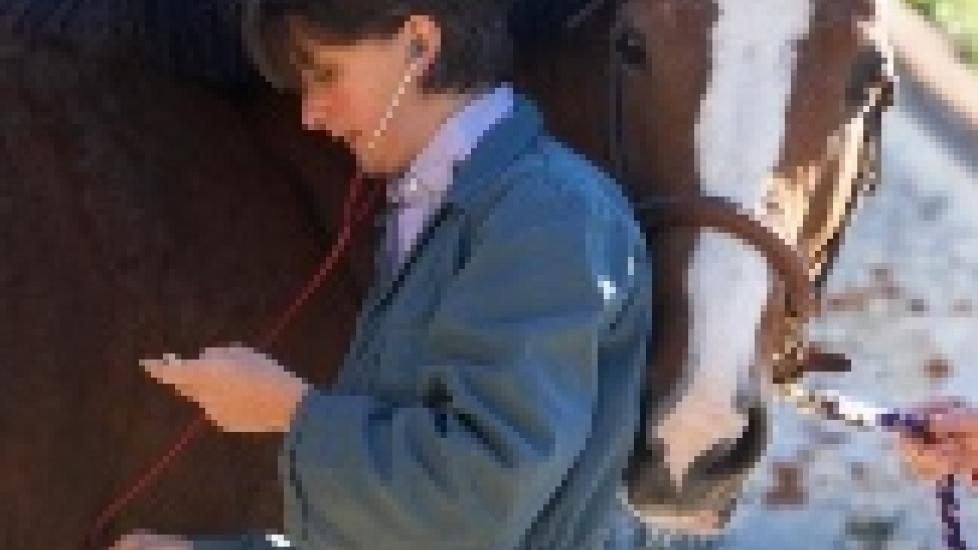Anatomy and Care of a Horse's Heart
Veterinary cardiology specialties, while once unheard of, are now seemingly everywhere in major metropolitan areas. Specializing in Poodles with cardiomyopathy and cats with irregular heartbeats, these cardiologists are waiting with stethoscope in one hand and ultrasound in the other to diagnose all your small animal’s needs. But what about the farm animals?
Although in our vet school cardiology classes we learned about the most common heart conditions in horses and cattle, once in senior year clinics it was evident there was no Large Animal Cardiology rotation — the cardiologists never even came into the large animal hospital. We did run EKGs on horses prior to routine anesthesia for surgical procedures, but the anesthesiologists, not cardio people, evaluated those. Out on the farm, what were we supposed to do if we had a bull in heart failure?
In short: nothing.
Recommended Pet Products
- Nutramax Proviable Probiotics & Prebiotics Digestive Health Supplement for Dogs & Cats, 160 count$89.98Chewy Price
- Fera Pets USDA Organic Pumpkin Plus Fiber Support for Dogs & Cats, 90 servings$34.95Chewy Price
- All Four Paws Comfy Cone E-Collar for Dogs & Cats, Black, Small$20.24Chewy Price
- Virbac Epi-Otic Advanced Ear Cleaner for Dogs & Cats, 4-fl oz bottle$12.34Chewy Price
That’s not to say that a valuable farm animal perhaps wouldn’t be sent to a referral clinic for advanced cardio workup if it were financially feasible for the owner. But most of the time, with a few exceptions, a cardiac problem in livestock isn’t even diagnosed.
An athletic horse whose performance is suffering is another situation entirely. Extremely athletic horses, just as with human athletes, can develop abnormal heart sounds solely because their hearts are so fit. In horses, this is known as physiologic atrio-ventricular block and shows up on an EKG sometimes as missed heart beats.
The anatomy of a horse’s heart is interesting in itself. Yes, it is big — the average adult horse’s heart weighs between seven and nine pounds — but a horse’s heart has structural similarities to other large mammals such as whales. It’s called a category Type B heart.
Category Type B hearts have electrical impulse conducting fibers called Purkinje fibers that are very diffuse, penetrating deep into the heart muscle tissue. This means electrical conduction, which is necessary for the heart to beat, can occur very quickly — something important when one has a large heart. In contrast, cats, dogs, and humans have category Type A hearts. We still have Purkinje fibers, but they aren’t as diffuse throughout the heart muscle.
Atrial fibrillation is the most common arrhythmia (irregular heart beat) in horses. Noticed mostly in athletic horses that abruptly are unable to perform at peak levels, this heart condition occurs when electrical impulses to the atria of the heart prevent normal contraction and relaxation of the muscle. Instead, the atria flap in uncoordinated and inefficient beats, leading to decreased cardiac output and a less efficient heart.
If no other heart disease is present, atrial fibrillation in horses can be treated. In many cases, this condition is not ever found or found by accident, like when a vet is listening to a horse’s heart during an annual physical exam. Many times, if the horse isn’t expected to perform at demanding levels, “a-fib” can be left alone. If the horse is used for competition, however, owners may elect to treat. An interesting concept, antiarrhythmic drugs can be used to “convert” the heart back to a normal rhythm, somewhat similar to splashing cold water on a hysterical person to calm him or her down.
In my practice, I’ve never come across atrial fibrillation, or really any other major cardiac issue in a horse, for that matter. But I’m sure colleagues working with racing Thoroughbreds, or other high performing equine athletes see it once in a while.
Next week we’ll take a look at an unusual cardiac condition seen occasionally in cattle called hardware disease.

Dr. Anna O'Brien
Image: Thinkstock




